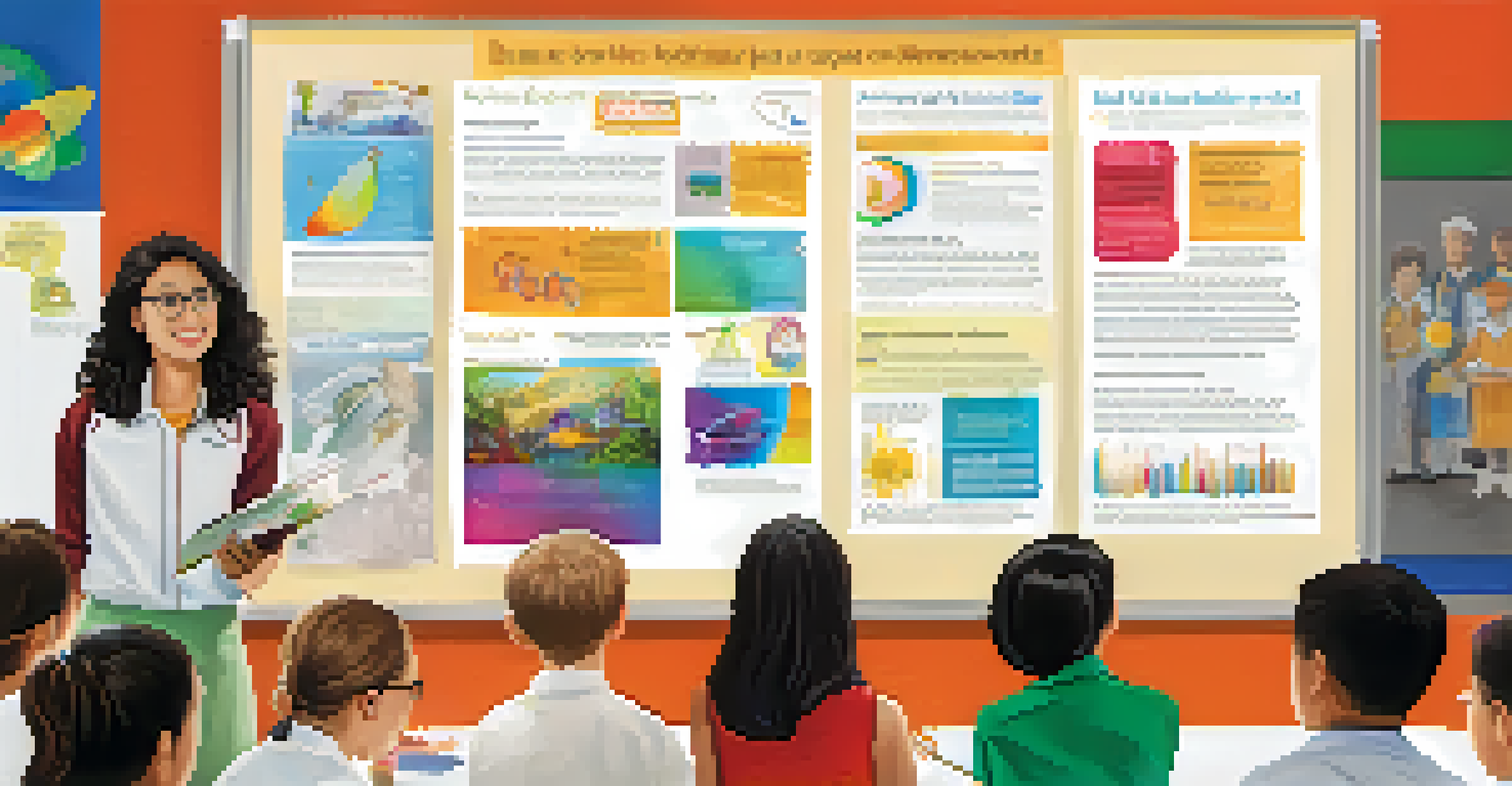Interdisciplinary Learning: Strategies for Teacher Development

Understanding Interdisciplinary Learning in Education
Interdisciplinary learning involves integrating multiple subjects to enhance understanding and engagement. Imagine a classroom where math, science, and art come together to explore the concept of symmetry. This approach not only makes learning more cohesive but also mirrors real-world situations where disciplines intersect.
Education is not the filling of a pail, but the lighting of a fire.
Teachers play a crucial role in facilitating this type of learning by breaking down traditional subject barriers. By collaborating across disciplines, educators can create rich, relevant lessons that spark students' curiosity. For example, a project on climate change could involve science, geography, and even literature, giving students a comprehensive view of the topic.
Ultimately, interdisciplinary learning fosters critical thinking and problem-solving skills, preparing students for a complex world. As they navigate through various perspectives, students learn to appreciate the interconnectedness of knowledge and its application in everyday life.
The Benefits of Interdisciplinary Learning for Teachers
One of the most significant benefits for teachers is the opportunity for professional growth. By working with colleagues from different disciplines, educators can gain new insights and teaching strategies. This collaborative environment encourages sharing best practices and resources, enriching the overall teaching experience.

Additionally, interdisciplinary learning helps teachers stay engaged and motivated. When educators explore new ways to connect subjects, they often rediscover their passion for teaching. This renewed enthusiasm can translate into more dynamic and effective classroom experiences for students.
Interdisciplinary Learning Enhances Engagement
Integrating multiple subjects fosters a more cohesive and engaging learning experience for students.
Moreover, teachers who embrace this approach can cultivate a more adaptable mindset. In today’s rapidly changing educational landscape, flexibility is key. By learning to integrate various disciplines, teachers can better respond to student needs and tailor their instruction accordingly.
Strategies for Implementing Interdisciplinary Learning
Effective implementation starts with collaboration among educators. Forming cross-disciplinary teams can help facilitate the planning of integrated lessons. Regular meetings to brainstorm ideas and share resources are essential, ensuring everyone is on the same page and working towards common goals.
The beautiful thing about learning is that no one can take it away from you.
Next, teachers should design projects that naturally lend themselves to interdisciplinary connections. For instance, a historical event could be explored through literature, art, and music, allowing students to see the event from multiple angles. This not only enhances engagement but also deepens understanding.
Lastly, incorporating technology can streamline the process. Utilizing digital tools for communication and project management can help teams work more efficiently. Platforms like Google Classroom or collaborative apps can make it easier to share resources and track progress.
Creating a Supportive Environment for Teachers
A supportive environment is crucial for fostering interdisciplinary learning. School leadership should encourage collaboration by providing time and space for teachers to meet and plan together. This not only demonstrates a commitment to professional development but also helps build a strong community among educators.
Additionally, offering professional development opportunities focused on interdisciplinary strategies can empower teachers. Workshops, training sessions, or mentoring programs can provide valuable insights and practical tools. This kind of support helps teachers feel more equipped to take risks in their teaching.
Collaboration Benefits Teachers
Working with colleagues across disciplines allows teachers to grow professionally and rediscover their passion for teaching.
Recognizing and celebrating successful interdisciplinary projects can also boost morale. Sharing success stories in staff meetings or newsletters fosters a culture of collaboration and encourages others to try similar approaches.
Assessment in Interdisciplinary Learning
Assessing students in an interdisciplinary context can be challenging but rewarding. Traditional assessment methods may not fully capture a student's understanding of integrated concepts. Instead, educators should consider project-based assessments that evaluate students' ability to apply knowledge from multiple disciplines.
Rubrics tailored to interdisciplinary projects can help ensure that students are evaluated fairly on their work. These rubrics can include criteria for collaboration, creativity, and critical thinking, in addition to subject-specific knowledge. This holistic approach provides a more comprehensive view of student learning.
Feedback is also essential in this process. Providing constructive feedback on interdisciplinary projects encourages students to reflect on their learning and understand the connections between different subjects. By fostering a growth mindset, teachers can help students appreciate the value of this integrated approach.
Overcoming Challenges in Interdisciplinary Teaching
While interdisciplinary learning offers numerous benefits, it’s not without its challenges. One common hurdle is time constraints, as teachers often juggle multiple subjects and standards. However, by prioritizing collaboration and planning, educators can find effective ways to integrate disciplines without overwhelming their schedules.
Another challenge is the potential for mismatched goals among teachers. It’s crucial for educators to align their objectives and expectations for interdisciplinary projects. Open communication and a shared vision can help mitigate misunderstandings and ensure a cohesive approach.
Assessment Must Evolve with Learning
Project-based assessments tailored to interdisciplinary work provide a more comprehensive view of student understanding.
Finally, some educators may feel apprehensive about venturing outside their subject expertise. Encouraging a growth mindset can help alleviate these fears. Teachers should remember that interdisciplinary learning is a journey, and it's perfectly okay to learn and grow alongside their students.
Future Directions for Interdisciplinary Learning
As education continues to evolve, so too will the strategies for interdisciplinary learning. The integration of technology into classrooms presents new opportunities for collaboration and creativity. Virtual reality experiences, for example, can immerse students in a learning environment that blends various subjects seamlessly.
Additionally, there is a growing emphasis on social and emotional learning (SEL) within interdisciplinary frameworks. Educators are recognizing the importance of nurturing students' emotional intelligence alongside academic skills. This holistic approach can help students thrive in both their personal and academic lives.

Looking ahead, it’s essential for educators to remain adaptable and open to new ideas. By continuously exploring innovative methods for interdisciplinary learning, teachers can equip their students with the skills necessary to navigate an increasingly complex world.